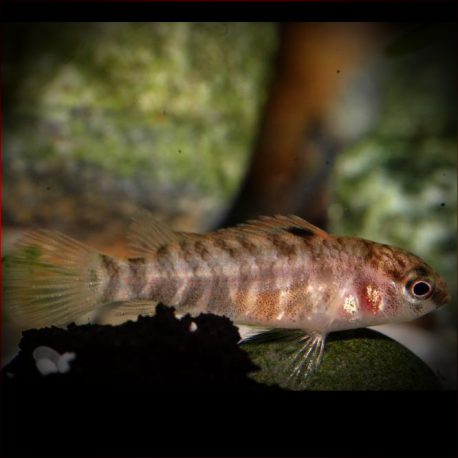More info
Datasheet
| Minimum Tank Size | 60 litres / 15.85 US gallons |
| Maximum Size | 5.0cm / 1.97inches |
| Temperature | 15°C / 59.00°F - 25°C / 77.00°F |
| Hardness | 1.01dgH / 18ppm - 5.04dgH / 90ppm |
| pH | 6.5-7.5 |
General Description
The Badis Sp. 'Buxar' is an undescribed species that belongs to the family Badidae within the Perciformes order. It reaches a maximum size of 5.0cm and requires a minimum tank size of 60 litres to thrive in captivity. The species is a micropredator, feeding on small aquatic crustaceans, worms, insect larvae, and other zooplankton, being somewhat picky eaters in aquariums.
Aquarium Setup
For an optimal aquarium setup for Badis Sp. 'Buxar', a well-structured environment is key. This includes a substrate of sand or gravel, along with water-worn rocks, pebbles, and ample cover provided by driftwood, twigs, branches, floating plants, and leaf litter. The addition of plant species like Microsorum, Taxiphyllum, or Anubias is optional. Filtration and lighting should not be too strong, with the inclusion of cave-like structures for potential spawning sites.
Behaviour
The Badis Sp. 'Buxar' is not a gregarious fish and can display aggression towards rival males, particularly in smaller tanks. It is recommended to keep them alone or in pairs to avoid aggressive interactions. When housed in a community tank, tankmates should be carefully chosen, preferably peaceful cyprinids or surface-dwelling species. Combining them with territorial bottom dwellers or similar-looking fish should be avoided to prevent hybridization.
Feeding and Diet
Badis Sp. 'Buxar' are slow and deliberate feeders, preferring small live or frozen foods such as Artemia, Daphnia, or bloodworm. They may not readily accept dried foods but can be trained over time. It is important to avoid feeding them chironomid larvae or Tubifex to prevent obesity and diseases.
Reproduction & Dimorphism
Successful breeding of Badis Sp. 'Buxar' in captivity has been reported, with individuals showing a preference for the upper temperature range. They form temporary pair bonds and usually lay 30-100 eggs after an intricate courtship process. Males exhibit territorial behavior during breeding, guarding the eggs and fry once hatched. Females are smaller and have duller patterning compared to males, who develop extended finnage as they mature.
Habitat and Distribution
While the habitat of Badis Sp. 'Buxar' is unknown, it is expected to reside in typical Badis species habitats in northeastern India, such as shallow, slow-moving streams with dense vegetation. The species is named after the Buxa National Park in West Bengal, near the Bhutan border.

